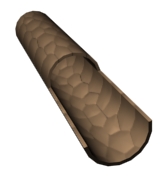The role of diffusion in and within cells
What is diffusion? Diffusion is a passive process, it does not require any energy for it to happen. The easiest kind of diffusion is when different gases diffuse through each other. For example, it happens when a perfume smell spreads through out the air in an enclosed area. Likewise, diffusion of gases also take place in the leaves.
In scientific terms, DIFFUSION is the MOVEMENT OF PARTICLES from a region of HIGH CONCENTRATION to a region of LOW CONCENTRATION.
Exchange of gases in
the Lungs
Breathing is a gas
exchange mechanism. Your Lungs help to
do just that! They contain millions of tiny
air pockets called ALVEOLI (air sacs)
which are adapted to maximise the diffusion of carbon dioxide and oxygen (see diagram
below). Alveoli are good at gas exchange because
they have:
In the alveolus (single air sac) oxygen passes from a high concentration (loads of oxygen) through the thin wall into the blood capillary where there is a low concentration (very little oxygen) . This is called diffusion, because oxygen is moving from high concentration to low concentration. When blood returns to lungs it has high concentration of carbon dioxide, so CO2 diffuses out of the blood into the alveolus.

Summary: